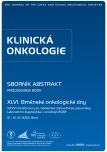Pilot analysis of the PD-L1 expression in ovarian cancer patients treated with platinum-based chemotherapy
Authors:
J. Hausnerová 1; L. Ehrlichová 2; P. Ovesná 3; E. Gazárková 4; J. Chlubnová 2; K. Matulová 1; Luboš Minář 4; Vít Weinberger 4; Markéta Bednaříková 2
Authors‘ workplace:
Ústav patologie, LF MU a FN Brno
1; Interní hematologická a onkologická klinika LF MU a FN Brno
2; Institut bio statistiky a analýz, MU Brno
3; Gynekologická a porodnická klinika LF MU a FN Brno
4
Published in:
Klin Onkol 2022; 35(Supplementum 1): 135-137
Category:
Article
Overview
Background: At present, there is no relevant data considering the prevalence and clinical significance of immunohistochemical (IHC) assessment of programmed death ligand-1 (PD-L1) expression in ovarian cancer (OC). Therefore, as a part of our research project of comprehensive profiling of OC, we aimed to analyze PDL1 IHC expression in OC patients treated with platinum-based chemotherapy (P-CT). Materials and methods: The retrospective cohort of 50 patients treated with at least by 6 cycles of primary systemic P-CT at University Hospital Brno in the years 2010–2020 was identified from the clinical database based on predefined criteria. The tumor samples of all involved patients collected before P-CT initiation were IHC analyzed for PD-L1 expression using monoclonal antibody (clone 22C3, Agilent). The slides were scored for TPS (percentage of positive tumor cells) and CPS (combined positive score defined as the number of all positive tumor cells, lymphocytes and macrophages divided by the number of vital tumor cells and multiplied by 100). Results: A total of 25 patients had P-resistant disease (with median platinum-free interval (TFIp) 1 month and overall survival (OS) 10 months) and 25 patients had P-sensitive disease (with TFIp 14 months and OS 51 months in 15 (60 %) patients with recurrence). The stage at diagnosis, histological type and extent of cytoreduction were equally distributed in both cohorts. In the P-resistant cohort, the IHC PD-L1 expression results were as follows: TPS negative in 24 (96%) patients, TPS positive in 1 (4%), CPS < 1 in 13 (52%), CPS 1–10 in 9 (36%) a CPS 10–100 in 3 (12%) patients. The results in the P-sensitive cohort showed negative TPS in 23 (92%), TPS positive in 2 (8%), CPS < 1 in 12 (48%), CPS 1–10 in 7 (28%) and 10–100 in 6 (24%) patients. Conclusion: The results of the extended analyses of the correlation between PD-L1 expression and clinicopathological characteristics will be presented at the conference.
Keywords:
immunohistochemistry – ovarian cancer – anti-PD-L1 antibody
Sources
1. Sung H, Ferlay J, Siegel RL et al. Global cancer statistics 2020: GLOBOCAN estimates of incidence and mortality worldwide for 36 cancers in 185 countries. CA A Cancer J Clin 2021; 71(3): 209–249. doi: 10.3322/ caac.21660.
2. Teng MW, Ngiow SF, Ribas A et al. Classifying cancers based on T-cell infiltration and PD-L1. Cancer Res 2015; 75(11): 2139–2145. doi: 10.1158/ 0008-5472.CAN-15-0255.
3. Marincola FM, Jaffee EM, Hicklin DJ et al. Escape of human solid tumors from T–cell recognition: molecular mechanisms and functional significance. Adv Immunol 1999; 74 : 181–273. doi: 10.1016/ S0065-2776(08)60911-6.
4. Hwang WT, Adams SF, Tahirovic E et al. Prognostic significance of tumor-infiltrating T cells in ovarian cancer: a meta-analysis. Gynecol Oncol 2012; 124(2): 192–198. doi: 10.1016/ j.ygyno.2011.09.039.
5. Gottlieb CE, Mills AM, Cross JV et al. Tumor-associated macrophage expression of PD-L1 in implants of high grade serous ovarian carcinoma: a comparison of matched primary and metastatic tumors. Gynecol Oncol 2017; 144(3): 607–612. doi: 10.1016/ j.ygyno.2016.12.021
6. Chen H, Molberg K, Strickland AL et al. PD-L1 expression and CD8+ tumor-infiltrating lymphocytes in different types of tubo-ovarian carcinoma and their prognostic value in high-grade serous carcinoma. Am J Surg Pathol 2020; 44(8): 1050–1060. doi: 10.1097/ PAS.0000000000001503.
7. Xue C, Xu Y, Ye W et al. Expression of PD-L1 in ovarian cancer and its synergistic antitumor effect with PARP inhibitor. Gynecol Oncol 2020; 157(1): 222–233. doi: 10.1016/ j.ygyno.2019.12.012.
8. Eymerit-Morin C, Ilenko A, Gaillard T et al. PD-L1 expression with QR1 and E1L3N antibodies according to histological ovarian cancer subtype: a series of 232 cases. Eur J Histochem 2021; 65(1): 3185. doi: 10.4081/ ejh.2021.3185.
9. Buderath P, Mairinger F, Mairinger E et al. Prognostic significance of PD-1 and PD-L1 positive tumor-infiltrating immune cells in ovarian carcinoma. Int J Gynecol Cancer 2019; 29(9): 1389–1395. doi: 10.1136/ ijgc-2019-000 609.
10. Yu J, Wang X, Teng F et al. PD-L1 expression in human cancers and its association with clinical outcomes. OTT 2016; 9 : 5023–5039. doi: 10.2147/ OTT.S105862.
Labels
Paediatric clinical oncology Surgery Clinical oncologyArticle was published in
Clinical Oncology

2022 Issue Supplementum 1
Most read in this issue
- VIII. Radioterapeutické metody a radiofarmaka
- IV. Follow-up, sledování onkologických pacientů
- XXVIII. Neuroendokrinní a endokrinní nádory
- XXII. Nádory slinivky, jater a žlučových cest
